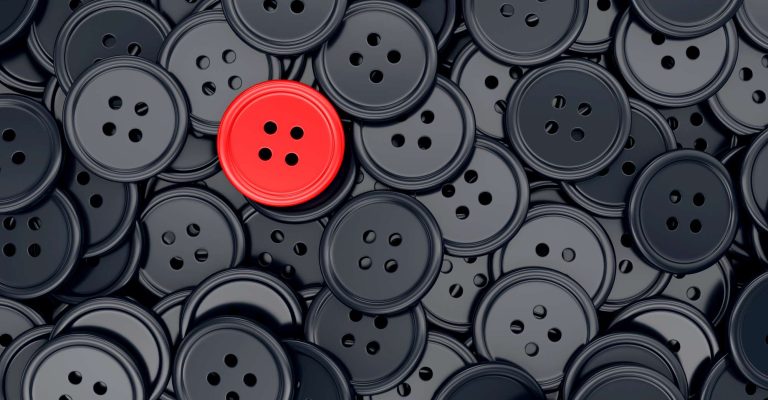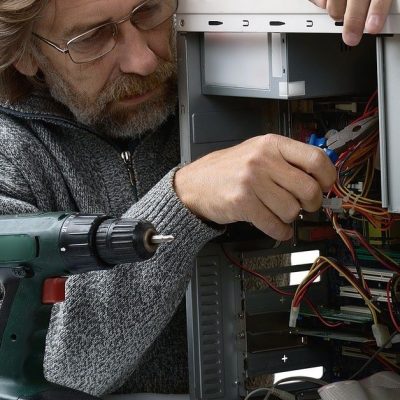VA or NVA: Defects and Extra Processing
Ahhhh, WIBNI…! Wouldn’t It Be Nice If all the lean wastes in your process were as easy to spot as the wrong-color button in the nearby photo of Finished Goods Inventory (FGI) at the button factory.
One of the obstacles I’ve found to eliminating waste in a process is people’s reluctance to consider that the process could even have “waste” in it. Nobody sets out to implement a process with waste included. There is no process operation called “Insert Waste,” just as there is no operation called “Insert Quality.” (The 8 types of Lean Waste are described here.)
Instead look at Lean Wastes or Non-Value-Add (NVA) as an “implicit cost.” Waste in the process means you are spending money you should not be spending. It’s not an explicit spend, such as a purchase order or a contract with a supplier. Rather, it is a cost that arises because something was overlooked – a process step, a self-check, or neglecting to consider poka-yoke – mistake-proofing a procedure.
Two of the most common sources of implicit cost are Defects and Extra Processing. The two are often related – the presence of defects leads to the inclusion of extra processing in a factory or business process. Let’s examine these in some depth.

Defects
Lean Six Sigma is about the pursuit of perfection in the face of obstacles to achieving it. You will probably not be able to achieve perfection in any product or service during the short time span of its existence. However, the pursuit of perfection – and the learning it necessitates – is likely to result in product or service excellence.
Many process owners complicate their ability to eliminate defects by failing to determine what a defect is. So let’s start there. An operational definition I have used for many years is:
A defect is any discrepancy that, if we know of its existence, would cause us to decide not to ship the product to a customer, or move it to a downstream operation.
With that definition we can begin the search for the NVA described as “Defects.”
Two quick questions. First question: Where are defects created? If you look carefully, the process flow diagram will tell you. Several potential sources are apparent, such as: incoming material and components; manual and automated assembly process steps; rework process operations; designed-in defects due to improper tolerancing, for example; and others.
If care is not taken, many defects due to these sources can remain hidden until after product sale and placement into service, and then possibly cause failures in end use.
Second question: Where are defects detected? Ideally, in any process the detection point should be very close to the creation; that is, as soon as a defect occurs, it becomes obvious to the operator, technician, or whoever manages that part of the process. In typical processes, there are inspections and tests, or at least some process checks, either at the end of the process or distributed through the process, to expose defects.
You will sometimes hear, “Assuming our process is in control, we shouldn’t need any test.” However, any inspection or test is fundamentally a series of measurements. Without measurements, controlling the process is impossible and relies on hope to get things right.
In Lean Six Sigma process design, one of our process control objectives is to eliminate the causes of defects instead of inspecting or testing to find them. Incorporating a flexible inspection and test arrangement into a new process will allow you to reduce the time spent in detection, as defects are found, root causes are identified and eliminated at their source, and the process capability improves over time.
It’s also important to include procedural validation to confirm that intended users can perform the process correctly every time, as a means of preventing procedural or process errors.
Extra Processing
Just as there is no block in anybody’s process flow diagram identified as “Insert Defects,” there is also no block called “Extra Process Step.” Yet, both types of NVA occur in nearly all processes unless deliberate effort is expended from the start when designing the process.
Extra Processing can take the simple form of inspection after the fact; that is, at the end of an assembly process there are people whose job is to inspect each unit thoroughly to ensure it is correctly built. In a more complicated instance, Extra Processing can entail diagnosis, repair, and re-processing of complete or partial assemblies during the forward flow of the production process. Both instances should be treated as NVA.
There are instances of Extra Processing not related to defects. Examples I have seen include: collecting and storing large amounts of “just-in-case” data that are rarely or never used; specifying tighter tolerances on components than necessitated by their function; and performing surface finishing on parts or subassemblies that are not visible in end use or during servicing. All of these are also NVA.

Eliminating Defects and Extra Processing (Lean Wastes)
But isn’t it “more efficient” to build product as fast as possible and just inspect or test for defects at the end? That way, we only have to deal with the small percentage of bad units that are caught. Ship the good ones and fix the bad ones so we can ship them too, right?
I have often heard that expressed in some manner by technicians, managers, and others who ought to know better. A quick story will illustrate the fallacy.
I had been Manufacturing Director in a new company for a few weeks. Past experience had solidified my habit of searching for lean wastes. Walking the production floor one morning, I noticed a test technician with a half-dozen disassembled units on his bench, with their main circuit boards removed so he could scope them.
I asked what was happening; seems that one IC chip on the boards was not getting the +3.3VDC power it was supposed to have. Same chip, same problem on all units. He said he frequently had this problem with these boards, which were assembled by a nearby contract manufacturer (CM).
To the technician, this is “just the way it is.” To me, it is a glaring example of implicit cost, Big NVA.
I went to see the Purchasing manager and asked her what testing the CM did on these boards. She replied, “We don’t let them test. Testing costs extra.” Then added, for good measure, “Your people need to get better at debugging.”
In her view, she saved the company maybe a dollar (“her money”) by bringing in untested boards. Unfortunately, Production had to spend 15 dollars or more (“my money”) per unit product for extra processing to repair the defective boards.
Fast forward a few days; Purchasing and Manufacturing resolved our cognitive differences. We persuaded the CM to find and correct the process problem that caused the circuit board failures in our line and to institute a 20-second process control test in their factory.
The irony – the CM never knew we were finding defective boards, because the purchasing manager had never told them! Further, when they became aware of it, their process corrective action took a few hours to implement, with no added cost, so the CM’s price to our company did not go up. And once the correction was seen to be effective, their 20-second test was removed with our consent. A Win all the way around!
Defect eliminated at the source – check! Extra processing eliminated – check!
On the lookout for the next NVA, knowing more lean wastes are lurking out there. It didn’t take long, about one afternoon if I recall correctly.
As the riddle says, How do you eat an elephant?
Answer: One bite at a time.
Dann Gustavson, PMP®, Lean Six-Sigma Black Belt, helps Program Managers and their teams achieve superior results through high-impact program execution. Prepare, structure, and run successful programs in product engineering, manufacturing operations (including outsourcing), and cross-functional change initiatives.
Contact Dann@Lean6SigmaPM.com.
